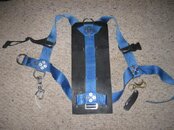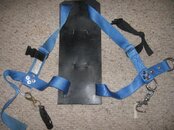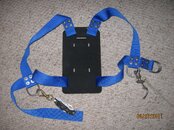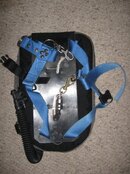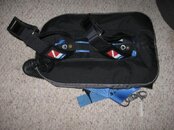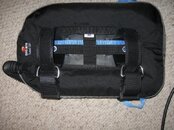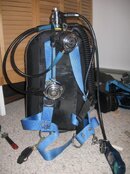Offer them in purple!
You are using an out of date browser. It may not display this or other websites correctly.
You should upgrade or use an alternative browser.
You should upgrade or use an alternative browser.
Building a Better BC
- Thread starter NC Air Hog
- Start date
Please register or login
Welcome to ScubaBoard, the world's largest scuba diving community. Registration is not required to read the forums, but we encourage you to join. Joining has its benefits and enables you to participate in the discussions.
Benefits of registering include
- Ability to post and comment on topics and discussions.
- A Free photo gallery to share your dive photos with the world.
- You can make this box go away
mikeycanuk
Contributor
Our 3 ScubaPro GO's are pretty close to perfect, sorry tbone I have no clue as to what you are talking about, and I don't have to.
It's similar situation to regs, there isn't much left to improve upon, other than cosmetic ones.
Sent from my iPad using Tapatalk HD
It's similar situation to regs, there isn't much left to improve upon, other than cosmetic ones.
Sent from my iPad using Tapatalk HD
Some jacket style recreational BC's work fine. They are good for teaching, economical, and simple. Others are so boogered up with useless features, accessories, padding, etc. and way overpriced. BPW's are sort of moving in that direction from some mfg's. The X tek line comes to mind. Just plain stupidly expensive and seem more designed for flash and to maximize profit over function. I can see the need for some development in plate design. I love my Freedom Contour plate and for single tank diving prefer it over any of my other ones. I have two DSS plates and, at this point with where my diving has evolved to, no idea why I have both of them. Other than to put an intro to tech student in with the last set of doubles I have. I have one set of LP 72's and a 38 lb HOG wing that is an ideal rig for the students I have had that want to try a twin set. Others are seeing the benefits of sidemount and for that I have three rigs.
One area I see that is offering challenges for some students with BPW leanings is in the harness. The std harness set up can be problematic for some. I had one student this past season that the basic HOG harness just would not work for. We tried numerous adjustments and it was only when I put him in a Manta Deluxe Harness that everything fell into place. His body type was the issue. Adjusted to that with a harness using a chest strap and different angle of attack and it worked. What I didn't care for was the double the cost involved. Student was fine with it but others might not be. And I do not like to operate that way.
There are some new ideas in the works that I think divers will like and will work well. As long as the cost is reasonable. Wings are pretty much good IMO. Plates could always incorporate new idea but aside from hole locations, maybe some accessories for attaching things, and weight/length considerations there is not a lot you can do. The harness is where I see the most need/desire for customization. Some may not see that. I didn't either for a long time. But with more people adopting it and the range of body types I see it being necessary to adapt. As long as it does not impact safety, function, and rescue considerations why not?
One area I see that is offering challenges for some students with BPW leanings is in the harness. The std harness set up can be problematic for some. I had one student this past season that the basic HOG harness just would not work for. We tried numerous adjustments and it was only when I put him in a Manta Deluxe Harness that everything fell into place. His body type was the issue. Adjusted to that with a harness using a chest strap and different angle of attack and it worked. What I didn't care for was the double the cost involved. Student was fine with it but others might not be. And I do not like to operate that way.
There are some new ideas in the works that I think divers will like and will work well. As long as the cost is reasonable. Wings are pretty much good IMO. Plates could always incorporate new idea but aside from hole locations, maybe some accessories for attaching things, and weight/length considerations there is not a lot you can do. The harness is where I see the most need/desire for customization. Some may not see that. I didn't either for a long time. But with more people adopting it and the range of body types I see it being necessary to adapt. As long as it does not impact safety, function, and rescue considerations why not?
Aqua-Andy
Contributor
I would like to try a plate that is designed for single tank diving. I have recently moved my trim weights from the cam bands to the back side of the plate by drilling eight holes to line up with the slots in the weights and then just zip tying them on. I could not believe how different the rig dove and how stable it felt. Now I'm left wondering the difference it would make if the tank was closer to my back. This is the only change I would like to see for now.
- Messages
- 20,561
- Reaction score
- 14,946
- # of dives
- I'm a Fish!
Andy, the DSS plates with the weight plates are absolutely spectacular. Not cheap, but man are they wonderful
I agree with Jim, the Freedom Contour plate is miles ahead of the doubles plates. I have even adapted mine to doubles.
Singles and doubles rest on the butt so a gap is created between the lower spine and cylinders. Filling that gap transfers some weight to the hips from the shoulders when on deck. The Freedom Plate is basically is a hand-crafted plate taking many of the features of the old Voit Snug Packs and updating them for wings, two cam bands, and in stainless steel. A metal plate with compound curves would require an investment in stamping tooling rather than laser cutting plate and bending on a sheet metal brake.
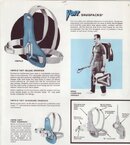
If you are looking for something to innovate, it is long overdue to update the doubles isolation manifold so it can be used valve-down or up with an integrated protector. This would go a long way to bring the redundancy that tech divers insist on to the general diving public who can certainly use it. Obviously the cylinders would be smaller and probably the cylinder centers for the recreational version. Here are images of the home-brew I use. It would be much more elegant if starting with a blank sheet including the manifold design.
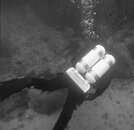
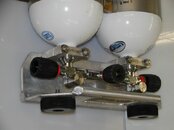
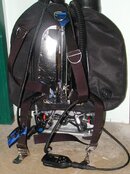
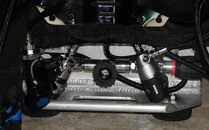
Singles and doubles rest on the butt so a gap is created between the lower spine and cylinders. Filling that gap transfers some weight to the hips from the shoulders when on deck. The Freedom Plate is basically is a hand-crafted plate taking many of the features of the old Voit Snug Packs and updating them for wings, two cam bands, and in stainless steel. A metal plate with compound curves would require an investment in stamping tooling rather than laser cutting plate and bending on a sheet metal brake.

If you are looking for something to innovate, it is long overdue to update the doubles isolation manifold so it can be used valve-down or up with an integrated protector. This would go a long way to bring the redundancy that tech divers insist on to the general diving public who can certainly use it. Obviously the cylinders would be smaller and probably the cylinder centers for the recreational version. Here are images of the home-brew I use. It would be much more elegant if starting with a blank sheet including the manifold design.




ams511
Contributor
sorry for this post ams
1. DSS plates are designed primarily for single tank use which is why they are flatter. The ridge is necessary whether in singles or doubles, but there's is a bit smaller. Halcyon and Dive Rite still sell most of their plates to doubles divers, though how long that lasts with sidemount coming up I'm not sure.
2. Halcyons and Dive Rites are generally harder to back because they require use of an STA which is a colossal pain to deal with in packing. What makes Oxycheq and Hollis harder to pack? Or are you just discussing the wing? The Dive Rite XT series is still pretty easy to pack flat with the Super Fabric.
3. The whole point of not having an STA is to just leave the rig set up for single tank diving. No need to break it apart even for travel. Unthread the cam bands and put the buckles on the underside of the plate and the whole thing lays pretty flat on its own. If you have an STA, it's just two quick wing nuts and it's in the 3 requisite pieces for packing.
4. no need to have quick adjusts, though DSS does have them. Adjusting BP/W's aside from the crotch strap is very easy provided you don't put slide locks on the back side of the plate. If you leave the slides out, you can adjust them quite easily on land, not quite so easy in the water, but if you loosen them up enough they are pretty easy to tighten underwater. Obviously nothing makes a crotch strap easy to adjust. DSS one is generally just used on the right side to make it easier to get in and out of though, but that's all you should really be using it for anyway.
5. STA's are still the best solution for those that go back and forth regularly between singles and doubles because it doesn't require rethreading of cam bands. During the summer when I'm not cave diving and am on the boats, I leave an STA on my 120's so I can switch my plate between my double 72's and my 120's as needed. With delrin thumb wheels it's super easy, and doesn't require rethreading cam bands. Have a second STA if I'm using a combination of 8" and 7.25" bottles so I don't have to adjust the cam bands. Doesn't happen often, but it happens. Usually the STA's are just on each 120, and instead of having to muck with getting the bands right it's just two thumb wheels, and plate and wing are off, throw it on the other tank, and I'm in and out faster and easier. If you have a dedicated singles rig, then DSS is probably the best system out there, backplate optimized for it, wing optimized for it, and it is priced right in there with Dive Rite, Hollis, etc, and almost half the price of the Halcyons
No need to be sorry, people can have differing opinions.
1) I have both styles of DSS plates, yes they are flatter but I cannot seem to tell the difference between their plates and other brands. However, a flat plate such as the old Jet plate or a contoured plate such as the Freedom plate could be a better option for those not wanting to use doubles.
2) Oxycheq and Hollis (I have a second gen wing) are difficult to pack because the fabric is stiff and not flexible. A Halcyon wing is very flexible and can roll easy and can pack up tighter than the Oxycheq even with the STA.
3) If you are going to a local dive site then yes just throw the rig into a tote and go. However for air travel I would not risk it. Tobin from DSS always says that the vast majority of wings are returned for pinch flats rather than punctures. He recommends disassembling the wing from the plate for transport and storage.
4) DSS, Halcyon, and Agir have adjustments so there does appear to be a market for it. Some people have mobility problems, switch wetsuit thickness, or have yo-yo weight gain/loss. I like when using an Oxy soft plate the ability to loosen and unloosen the straps. As for crotch straps SEAC and someone else have some sort of double crotch strap modeled after a parachute harness. An adjustment could be added to a crotch strap for people not using a scooter.
5) Usually people that dive both singles and doubles have different rigs for each. You are only talking about a new plate and webbing which if going cheap would only be about $100 or so.
If traveling is not an issue then I would recommend the Oxycheq, its build quality is much tougher. Halcyon has a better inner bladder than most wings is flexible but is pricey. My personal favorite is the UDT wing narrow but wider at at the hips were the weight belt is. The major drawback is it requires an STA. The best travel wing would be a DSS with a Zeagle or Oxycheq soft plate.
dumpsterDiver
Banned
- Messages
- 9,003
- Reaction score
- 4,652
- # of dives
- 2500 - 4999
I can think of a few ideas. The idea of putting weights on the tank neck is not the best. When I dove with a 7 mm jacket, 7 mm FJ, 3 mm vest and two hoods, for some odd reason, my torso was light.. i achieved better trim by hanging a 2-lb weight off the dront of the harness on the shoulders. Below me, not above me like a weight on the valve neck.
Smooth well designed shoulder weights that are integrated into the harness would be an improvement for this type of application.
Also, somewhat along the lines of the buni wings of death. Would there be a way to make an internal bladder constriction system that would constrict the bladder to a lower volume. If you could have a 40-lb bladder that would work for when the diver is in cold water and then pulling a few strings would uniformly reduce the bladder to 25 lbs or something would be nice if going on vacation in warm water. if the constriction were internal to the outer shell, you would retain a smooth outer appearance, but some material would be loose on the shell. If you had a few independent constriction "zones" you could also fine tune the shape of the bladder.... for example, I have found it beneficial to constrict the bladder on the venture wing right behind my neck so it doesn't push my head down when I look up.
Other changes to my BP/W - recently and adjustable harness that slides, also a loop of heavy bungi material on the rear of the plate/ or back pack which serves as the attachment for the crotch strap.. a slightly elastic crotch strap is nice.
Smooth well designed shoulder weights that are integrated into the harness would be an improvement for this type of application.
Also, somewhat along the lines of the buni wings of death. Would there be a way to make an internal bladder constriction system that would constrict the bladder to a lower volume. If you could have a 40-lb bladder that would work for when the diver is in cold water and then pulling a few strings would uniformly reduce the bladder to 25 lbs or something would be nice if going on vacation in warm water. if the constriction were internal to the outer shell, you would retain a smooth outer appearance, but some material would be loose on the shell. If you had a few independent constriction "zones" you could also fine tune the shape of the bladder.... for example, I have found it beneficial to constrict the bladder on the venture wing right behind my neck so it doesn't push my head down when I look up.
Other changes to my BP/W - recently and adjustable harness that slides, also a loop of heavy bungi material on the rear of the plate/ or back pack which serves as the attachment for the crotch strap.. a slightly elastic crotch strap is nice.
Many of us feel that the gear within the industry has become stagnant when it comes to BC innovation. I can remember the first time I heard about the "elevator handle" that had been developed on some of the Aqualung / Seaquest BC systems. All I could think is that it was a neat idea, but the way it was pitched to me was that it is the next big step in BC technology and soon everybody would copy it. I have noticed that this is not the case. Does anyone remember the wetsuits that were coming out with built in air pockets that would take the place of the BC? That idea never quite took off either. Now it seems that many of the companies are going to a backplate and wing hybrid mix with a BC. How can we build a better system? Should we change it at all?
The key to intelligent design is to start with the user, not the product. What problems/needs are not adequately addressed? You say that "the industry has become stagnant when it comes to BC innovation." If this is true (and I'm not saying it isn't) there should be a list of problems/issues/opportunities that are continually brought up. Identify those, and then set about design changes accordingly.
The reason the elevator-lever idea didn't take off is that it addressed a problem that the user didn't actually have. Innovation for innovation's sake is not innovation... it's merely "change."
Interestingly there was a paper discussing the idea that very often the people who are in a given industry are the bad at identifying existing problems/opportunities as well as the most effective solutions - they assume they know all the problems and have all the answers.
Integrating Problem Solvers from Analogous Markets in New Product Ideation
INFORMS PubsOnline.
Assuming that no one else has an online subscription to The Journal of Management Science :d here's a link to a Harvard Business Review article that cites the study:
Sometimes The Best Ideas Come From Outside Your Industrty
https://hbr.org/2014/11/sometimes-the-best-ideas-come-from-outside-your-industry

---------- Post added January 18th, 2015 at 11:02 AM ----------
problem with trying to redesign the bp/w is that it was optimized for what it does after decades of trial and error, so other than some slightly different wing shapes, they really haven't changed much.
As mentioned above...
:d
Last edited:
Rich Keller
Contributor
Similar threads
- Replies
- 44
- Views
- 3,395
- Replies
- 21
- Views
- 1,674
- Replies
- 179
- Views
- 13,851




